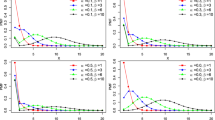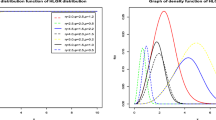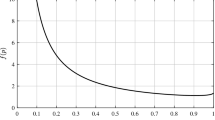Abstract
Conventional Bayes factors for hypotheses testing cannot typically accommodate the use of standard noninformative priors, as such priors are defined only up to arbitrary constants which affect the values of the Bayes factors. To circumvent this problem, Berger and Pericchi (1996, J. Amer. Statist. Assoc., 19, 109-122) introduced a new criterion called the Intrinsic Bayes Factor (IBF). In this paper, we use their methodology to test several hypotheses regarding the shape parameter of the power law process. Assuming that we have data from the process according to the failure-truncation sampling scheme, we derive the arithmetic and geometric IBF's using the reference priors. We deduce a set of intrinsic priors that correspond to these IBF's, as the observed number of failures tends to infinity. We then use these results to analyze an actual data set on the failures of an aircraft generator.
Similar content being viewed by others
References
Ascher, H. (1981). Weibull distributions vs. Weibull process, Annual Reliability and Maintain-ability Symposium, 426–431, IEEE, Chicago, Illinois.
Ascher, H. and Feingold, H. (1984). Repairable Systems Reliability, Marcel Dekker, New York.
Bar-lev, S. K., Lavi, I. and Reiser, B. (1992). Bayesian inference for the power law process, Ann. Inst. Statist. Math., 44, 623–639.
Berger, J. O. and Bernardo, J. M. (1989). Estimating a product of means: Bayesian analyses with reference priors, J. Amer. Statist. Assoc., 84, 200–207.
Berger, J. O. and Bernardo, J. M. (1992). Ordered group reference priors with applications to a multinomial problem, Biometrika, 79, 25–37.
Berger, J. O. and Pericchi, L. R. (1996). The intrinsic Bayes factor for model selection and prediction, J. Amer. Statist. Assoc., 91, 109–122.
Crow, L. H. (1982). Confidence interval procedures for the Weibull process with applications to reliability growth, Technometrics, 24, 67–72.
Duane, J. T. (1964). Learning curve approach to reliability monitoring, IEEE Trans. Aerospace Electron. Systems, 2, 563–566.
Lingham, R. and Sivaganesan, S. (1996). Testing Hypotheses about the power law process, Tech. Report 96-8, Department of Mathematical Sciences, University of Cincinnati, Ohio.
Rigdon, S. E. and Basu, A. P. (1980). The power law process: a model for the reliability of repairable systems, Journal of Quality Technology, 21, 251–260.
Author information
Authors and Affiliations
About this article
Cite this article
Lingham, R.T., Sivaganesan, S. Testing Hypotheses About the Power Law Process Under Failure Truncation Using Intrinsic Bayes Factors. Annals of the Institute of Statistical Mathematics 49, 693–710 (1997). https://doi.org/10.1023/A:1003218410136
Issue Date:
DOI: https://doi.org/10.1023/A:1003218410136




